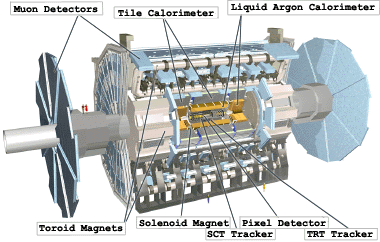ATLAS Semiconductor Tracker (SCT) and Inner Detector (ID)
ATLAS Semiconductor Tracker (SCT) and Inner Detector (ID)
 ATLAS is a general purposed CERN LHC-based detector designed to take full advantage of the very high energy (14TeV), high luminosity (1034cm-2s-1) proton-proton collisions of the LHC. ATLAS will be able to study the properties of the Higgs boson in a range of decay modes. ATLAS will also be sensitive to other exotic phenomena, such as: supersymmetry, extra dimensions, quark compositeness, and as yet unthought-of physics. At the heart of the ATLAS experiment is the inner detector (ID), which is composed of the Pixel, Semiconductor tracker (SCT) and transition radiation tracker (TRT).
ATLAS is a general purposed CERN LHC-based detector designed to take full advantage of the very high energy (14TeV), high luminosity (1034cm-2s-1) proton-proton collisions of the LHC. ATLAS will be able to study the properties of the Higgs boson in a range of decay modes. ATLAS will also be sensitive to other exotic phenomena, such as: supersymmetry, extra dimensions, quark compositeness, and as yet unthought-of physics. At the heart of the ATLAS experiment is the inner detector (ID), which is composed of the Pixel, Semiconductor tracker (SCT) and transition radiation tracker (TRT).
The Glasgow group have been involved from the start of the ATLAS experiment's inception. The group's hardware activities date from the CERN RD collaborations, set-up to study new technologies for the LHC experiments. They continued through a SCT and ID design and prototype stage; a production phase for SCT forward modules and power tapes, and ID cooling studies and prototyping; via the integration, installation and commissioning of the SCT and ID into the ATLAS experiment; to finally what one hopes will be a fruitful exploitation of the apparatus. The group remains involved in the maintenance and operation of the ATLAS SCT and ATLAS ID. The group's important hardware contributions to the ATLAS experiment in both the SCT and ID are given here:
ATLAS SCT
ATLAS SCT
Members of the Glasgow group worked with other ATLAS collaborators on:
- Forward module design and prototyping
- The system test for the SCT
- Testbeams at CERN and KEK for SCT modules
- Radiation testing of SCT hybirds and sensors
- Production testing of sensors for the forward modules
- The bonding and testing of ATLAS SCT modules at Glasgow
- Co-ordination of the integration of the Endcap in the Liverpool cleanrooms
- Design and production of on-disk power tapes
- Testing of endcap low mass power tapes before and after assembly
- Integration at CERN
- Design and prototyping of SCT cooling circuit components
Contact: C. Buttar
ATLAS ID
ATLAS ID
Members of the Glasgow group makes or has made significant contributions to the ID activites in the following areas:
- The Detector Control System (DCS), including:
- Co-ordinator of the ID environmental DCS
- The evaporative cooling system, which included:
- Design and prototyping of the SCT Barrel and Forward off-detector cooling components
- Co-ordination of the production of off-detector cooling components
- Reception tests for the evaporative heater system
- Co-coordinating the commissioning of the evaporative cooling system
- On-going expert on-call for the ID cooling system
Contacts: S. D'Auria, R. Bates

